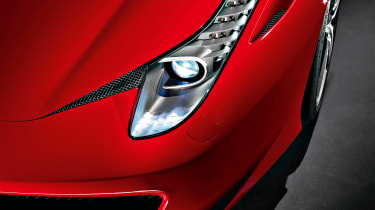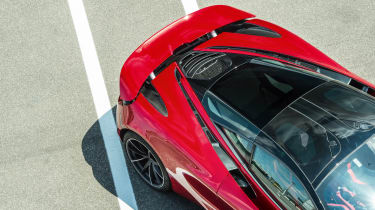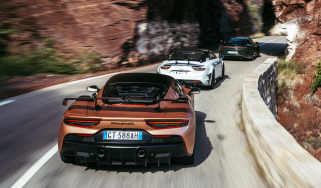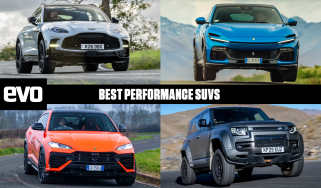How to design a car (part 12): the finale
Great car design is still possible. In the final instalment of this series, Stevens singles out some of his favourite examples from recent years

Having spent the last eleven months pointing out many of the design failings of recent cars, it seems appropriate that I should now discuss what I consider to be pieces of good modern design.
I would say nothing from the class of cars that are laughably and wrongly called SUVs qualifies. Maserati, Jaguar, Lotus, Aston Martin, Porsche, Bentley, Rolls-Royce, Alfa Romeo, BMW and Ferrari have all produced cars that, if it were physically possible, would have many men spinning in their graves. Alfieri, William, Colin, Lionel, Ferdinand, WO, Henry, Nicola, Karl and Enzo would all be just a whirling blur. Quite why these vehicles – ranging from just below to well above two tons – have to look so crudely contrived remains a mystery. Here are a group of manufacturers that have competed and won at Le Mans and Daytona, in the Mille Miglia and Formula 1, greedily countering the validation of their histories whilst using the excuse that the big profits made from SUVs allow them to carry on making the cars that evo readers enjoy. Oh, so an F8 or a 911 doesn’t make a profit?
And yet at the other end of the scale the little Honda E, particularly in gunmetal colours, is a perfect example of finely modelled restraint, whilst being instantly recognisable as a Honda. Can this excellent piece of product design really be from the same company that offers the chaotic Civic Type R? I sometimes think that Honda must have two or three studios that quietly get on with doing their own thing without a company design chief having a global vision for the designs.
> My Life & Cars – Peter Stevens, car designer
Renault, with both the Twingo and the not-so-little electric Zoe, is showing that it is not necessary to use the phrase ‘satisfying the Far Eastern market’ as an excuse for some of the styling extremes that more expensive brands hope to conquer China with. The Zoe is a chunky and slightly muscular statement, suggesting that an electric car can be a little dynamic and funky looking. There is a degree of forward rake to the body that implies an eagerness to get on with the job. As long as that job has a charging point at the other end.
The Audi R8 is a very understated and underrated piece of great product design. It is perhaps that modesty that stops it being on many people’s want list. The proportions and taut body surfaces, with crisp panel joints and body lines, suggest a design team that was very much under control, but sadly that discipline has been slightly overwhelmed by the latest ‘hatchet and boxing gloves’ development of the front face. Leaving aside the qualities of ride, performance and handling that are important to those who enjoy the thrill of driving, enthusiast owners want to be inspired to turn around and take a last look at their sports car at the end of a drive. (Oh yes you do!) Appearance does matter and the R8 is a car that does not shout ‘Look back at me!’
If you want something that looks great and differs from the rest of the crowded sports car market then the McLaren 720S does that. It is the only McLaren car that, whilst using the ubiquitous side-mounted radiators, takes the cooling air in through a clever, partly hidden intake duct, making the whole body side much cleaner than on other models. The simple air outlet behind the front wheel flows into the door surface, swelling gently as it approaches the rear wheel opening, making a very pleasing piece of form that is mirrored across the nose and rear deck surface that flows into the integrated rear spoiler.
The Ferrari 458 Italia is the cleanest statement of intent to come out of Maranello in recent years. The very simple but instantly recognisable front air intakes, the dramatic tail lights and the headlights that still owe something to the brilliant past Ferrari designer Leonardo Fioravanti are simple and unpretentious. The front screen, rear screen and side glass all appear to come from the same design hand – not always the case in terms of cross curvature. There are no tortured surfaces. The way the body skin appears to be stretched over strong muscle and bone suggests hidden power and energy to the viewer.
As a recent addition to the Geely-owned Volvo Group, Polestar has come a long way very quickly in design terms. Whilst there are traces of Volvo style to be seen in the Polestars 1, 2 and 3 there is a remarkable confidence in the design of all three cars. Unlike many of its long-established competitors, Polestar has not found it necessary to load the taught forms of its cars with wildly tortured body surfaces. The lights are as crisp and sharp as a surgeon’s knife cut, and there is none of that ‘taking a line for a stroll’ around the body panels that cheapens the appearance of any car.
Whilst the recent Land Rover Defender, particularly in ‘90’ form, is a well-proportioned vehicle with sharply defined surfaces, its place in the market seems defined by its price and advertising strategy. It is presented as a fashion accessory or town car rather than a rugged off-roader. The choice of materials for many of its vulnerable parts, if subjected to the use that a Defender’s form implies, seems bizarre. Whereas Ford’s recently launched Bronco exudes the rugged charm that the original model had. Less fussy in detail than recent Jeep models, and less trendy than a Defender, the Bronco looks like it will deliver what it says on the box. If you want a low-cost, unpretentious but uncompromised 4x4 that may not be able to tow a large horsebox or an Ariel Atom on a trailer, but can perform with remarkable effectiveness off-road, then the Suzuki Jimny could charm anyone who likes perfect proportions, nice details and a cheeky stance.
When it comes to medium-sized sporting saloon cars we have a number of expected new models from the Kia-Hyundai-Genesis group. With this group still under the watchful eye of ex-Audi chief designer Peter Schreyer, who has now been chief design officer with the Korean group for 16 years, high quality and high style remain a priority. The Genesis X concept EV shows the design direction that we can expect from Genesis chief creative officer Luc Donckerwolke and his team in the future. Even more interesting is the new Hyundai Prophecy concept EV, a new-generation car that has clearly spent useful time in the wind tunnel. Electric vehicles are only going to have a realistic future if the design and engineering emphasis is focused on efficiency, low weight, low drag and low frictional losses. Expressing these objectives is surely the task of designers working on the next generation of alternative powered vehicles.
This is true even if your brief is for the ultimate track day machine. It is quite possible that forthcoming electric or other alternative-fuelled cars, possibly with some autonomous capabilities, will so distance the driver/controller from the pleasure of driving that a track day car will become an essential piece of sports equipment. Looking gloomily ahead, maybe 20 litres of expensive fossil fuel for a weekend’s entertainment could be how we get our thrills behind the wheel.
Of course, we can do that right now in what I consider to be one of the most stylishly creative vehicles that you can currently buy: the BAC Mono. The Mono is not a seven-figure indulgence that could well become as socially unacceptable as a mink fur coat; it is an absolutely minimal, beautifully detailed masterpiece. The simple body surfaces cover just enough of the 580kg car’s mechanical components to intrigue the viewer to look more closely at the refined mechanisms. There is as much delight in looking carefully at a Mono as there is in seeing it flash past on the track or in being in charge of this mechanical marvel. And that is a result of the designers doing their job properly.
Nothing is harder, in design terms, than giving the impression through the design that the process was effortless, whilst nothing suggests a mixture of panic, laziness and indecision more strongly than a chaos of pointless lines and tortured surfaces that suggest aggression and insecurity. Thankfully there are still people out there who understand that.
This story was first featured in evo issue 301.





